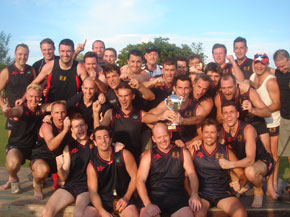FootyFeast presents Block on Northwind
- Thursday, June 12 2008 @ 07:11 am ACST
- Contributed by: Brett Northey
- Views: 3,327


Canada's premier league, the Ontario AFL, is leading the way in promoting the local clubs via a web-based footy show, featuring regular host Lockie McDonald and "panel" members Salvatore Capoferri and Emile Studham. Each episode features footage from the previous week's games, general footy gossip and plugs for the league's sponsors.
Recently, in episode four, the guys interviewed Canada's national coach, the Northwind's Mark Block. Currently also the Toronto Eagles coach and formerly the Northwind's captain at the 2002 International Cup, Block was very clear that he leads his side Down Under with the intention of winning the third Cup. Not surprisingly Papua New Guinea were seen as the biggest obstacle, and another bout with the United States was keenly anticipated.
It was also great to see the respect that Block had for a few "heritage" items from past Cups - something that will only be truly appreciated in the future. And speaking of the future, the clip also features first word of a new club forming, either the Quebec or Montreal Saints.
The episode can be viewed here, with the chat to Block starting around 18:35.



 The first US women's footy games of the year were held on Saturday (2nd June) with the inaugural 'Duel in the Desert' tournament hosted by the Arizona Lady Hawks. With temperatures expected to rise into the triple digits it was an early start with games starting not long after 8.00am. At the event were the newly formed Denver Lady Bulldogs and the Atlanta Lady Kookaburras as well as the hosts of course the Lady Hawks, runners-up at last years Nationals in Louisville.
The first US women's footy games of the year were held on Saturday (2nd June) with the inaugural 'Duel in the Desert' tournament hosted by the Arizona Lady Hawks. With temperatures expected to rise into the triple digits it was an early start with games starting not long after 8.00am. At the event were the newly formed Denver Lady Bulldogs and the Atlanta Lady Kookaburras as well as the hosts of course the Lady Hawks, runners-up at last years Nationals in Louisville.







 RSS news
RSS news Twitter
Twitter Facebook
Facebook